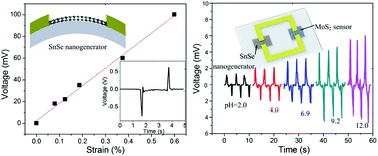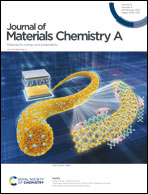A self-powered 2D-material sensor unit driven by a SnSe piezoelectric nanogenerator†
Abstract
We report the first experimental study of the piezoelectricity of 2D SnSe crystals. SnSe demonstrates a maximum piezoelectric output voltage of ∼760 mV, which is the highest voltage generated by a single piece of 2D material reported so far. The power density reaches 28 mW m−2 with a mechanical-to-electrical energy conversion efficiency of 6.5%. The piezoelectricity of SnSe is highly orientation dependent, and the piezoelectric signal along the armchair orientation is ∼5 times larger than that along the zigzag orientation. A SnSe piezoelectric nanogenerator is able to monitor human body motion and vital health signs, such as the heart rate, because of its unprecedented piezoelectricity. We demonstrate a solely 2D-material self-powered sensor unit (SPSU) by integrating a SnSe nanogenerator and a MoS2 multi-functional sensor on one chip. This all-in-one system powered by heartbeats and periodical bending demonstrates superb pH, illumination intensity, and humidity sensing performance. The sensing mechanism of the SPSU is investigated. The discovery of piezoelectricity in SnSe provides a way for achieving novel self-powered atomic-scale electromechanical systems which could stimulate further fundamental research and potential applications.



 Please wait while we load your content...
Please wait while we load your content...